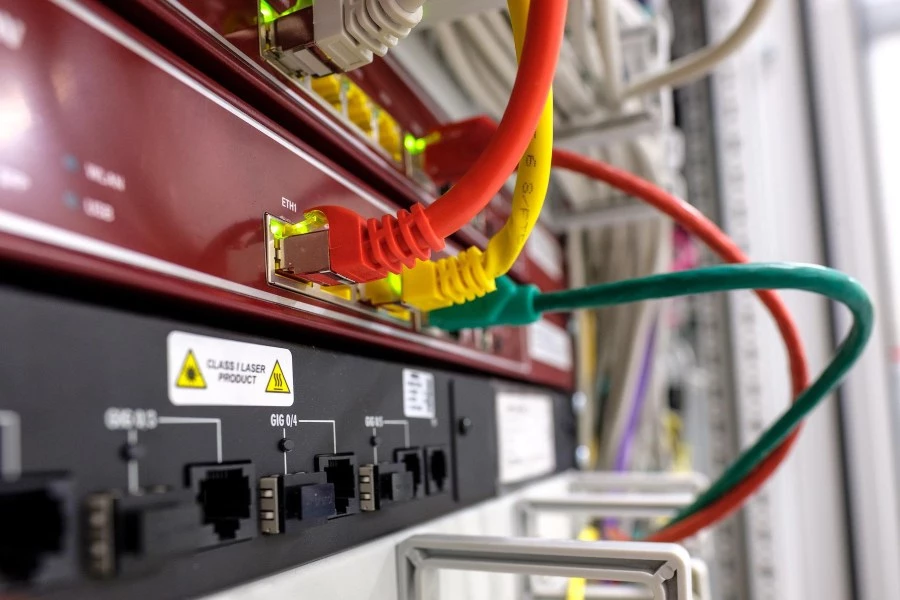
The growing demand for reliable data storage performance has fueled the need for personalized network storage systems. Besides, companies are also hunting for technologies that can ease communication between different users.
Most organizations use Local Area Network (LAN) and Storage Area Network (SAN) as their preferred system networks. Companies that opt for LAN have multiple devices with one communications or wireless link. On the other hand, SAN is ideal for dedicated networks and enables interconnection with shared storage devices.
Although both LAN and SAN switches deliver a data communication path, they differ significantly. Here’s what you need to know about these different switches.
What Is A LAN Switch?
Local area networks (LAN) interconnect multiple computers within a limited area. Switches are essential to fasten the communication within these networks. A LAN switch eases communication between paired devices and multiple users in a network.
During LAN switching, computers transfer data packets over the LAN network. This technology addresses existing bandwidth issues to enhance LAN’s efficiency. An IP-based switch creates a flexible connection between the transmitter and receiver in a LAN switch. This switch comprises multiple interconnected ports and links.
The LAN switch enables multiple users to share common resources while communicating efficiently. Also, the switch confines traffic to small LAN segments, reducing LAN congestion. With LAN switches, you’ll have an easier time creating multiple transmissions simultaneously. These switches can monitor the packet’s destination addresses.
LAN switching comprises:
- Hardware-based Layer 2 switching
- Layer 3 switching
- Layer 4 switching
- Multilayer switching
Regarding security, LAN switches boost higher-level security. Besides, you could have troubleshooting and management tools that automate its processes.
What Is A SAN Switch?
A storage area network (SAN) presents shared storage devices to multiple servers. The SAN switch is the device that connects the shared storage devices. Essentially, the SAN switch manages traffic flow between the servers and storage devices. These switches examine data packets and send them to the correct destinations.
Thousands of servers rely on SAN switches to access petabytes of data through vast high-speed storage networks. In SAN switching, high-speed switches and storage devices connect to specialized computer systems. Data transmission occurs once the network separates storage and host devices. Also, SAN switches are ideal for backing up and restoring data or data sharing across different servers.
With a SAN switch, administrators can create path redundancies that minimize the risk of expensive downtime. The Ethernet and Fiber Channel protocols inform the functionality of the SAN switch. These switches ensure that data packets get to the intended storage systems.
Typical Differences Between These Switches
Performance
LAN switches rely on IP-based Ethernet and operate on standard copper and optical interfaces. Most users prefer LAN switches for their simplified deployments and low network costs. With Layer 2 switches, you will enjoy low latency and high data transmission speeds. Also, LAN switches are ideal for anyone looking to use protocols with AppleTalk, TCP/IP, or IPX.
On the other hand, SAN switches get their inspiration from ISCSI storage networks. Compared to the LAN switch, these storage switches deliver a better storage ability. Also, users can predict the switch’s performance once they opt for the Ethernet-based SAN switch. These switches can create SAN structures that keep multiple servers connected when combined.
Overall, SAN switches top LAN switches for fast and efficient performance. However, these switches might cost you more because of the better performance. Suppose you’re looking to enhance LAN’s performance. In that case, you might need to work on the bandwidth performance of users in the network environment. Reducing lags on individual users impacts the rest of the network.
Applications
FDDI and Token Ring networks leverage Ethernet, paving the way for LAN switch applications. With proper application, LAN switches enhance local area network efficiency. Essentially, a LAN switch will direct traffic across multiple endpoints.
High-performance networks that deliver lossless data transmission work suitably with SAN switches. Besides, these switches are ideal for heavy transaction loads. Ideally, ensure that you dedicate the switch to storage traffic only.
SAN switches can handle heavy transaction amounts with ease. On the other hand, LAN switches specialize in resolving bandwidth issues. They also boost the overall performance of existing LANs. SAN switches also have tremendous storage capacity compared to LAN switches.
Many users prefer LAN switches for data transfer and communication, and leverage SAN switches to ease traffic flow on networks. LAN can help you transfer large data packets thanks to the numerous available ports. With this extended capability, LAN can deliver speeds of up to 100GbE. However, most users prefer the 10GbE switch, which supports diverse protocols, including TCP/IP, AppleTalk, IPX, and TCP/UDP.
Protocols
LAN protocols use various mediums to deliver data over shorter distances efficiently. LAN switches work on different protocols in multiple layers of the Open Systems Interconnect model. Top protocols include:
- Ethernet – This LAN protocol is standard in houses and offices, with the recognizable copper cable medium. All systems connect to the switch to complete data exchange.
- Token Ring – This older LAN technology has had fewer applications in recent years. Essentially, this protocol involved passing single tokens from one system to the next or via a hub. In this case, only the intended recipients will read the token.
- FDDI – This protocol highlights how LAN traffic moves over fiber cabling. Such cables come in handy when your LAN requires heightened security or longer distances.
Businesses and users looking for performance and sufficient storage space often resort to storage area networks. SAN switches rely on diverse protocols to deliver on most client needs:
- Fiber Channel Protocol (FCP) – This common SAN protocol combines with SCSI commands. Switches that use these protocols could either be modular director switches or fixed port semi-modular switches. These switches guarantee high performance, availability, low latency, and lossless data transmission.
- iSCSI – With this protocol, the switch puts SCSI commands inside Ethernet frames before transporting them over the IP Ethernet
- NvMe – If you’re looking to support countless parallel ques, the NvMe protocol will work suitably through multiple commands.
- Fiber Channel Over Internet – Like the iSCSI protocol, this protocol uses an IP Ethernet network for transport.
Typical LAN switches are cheaper and easier to deploy. Besides, they offer extended deployment flexibility and don’t require specialized hardware or skills.
Which Switch Should You Settle For?
Before choosing between a LAN and SAN switch, consider their performance requirements, interface speeds, and supporting protocols. Essentially, you’ll need a switch that best suits your specific network needs.
Your intended application always influences your choice of a network switch. Any user with fiber channel-based storage shouldn’t think twice about getting the SAN switch. For a switch to serve file-sharing protocol like IPX or Apple Talk, then the LAN switch will work seamlessly.
Also, you’ll need to assess the number of devices you need to connect to your network before settling on a preferred network switch. It is always helpful to settle for a switch with sufficient Gigabit ports for your team’s devices. Besides, a flexible switch lets you grow your network based on your evolving needs.
Overall, both LAN and SAN switches deliver seamless communication paths for data and storage. The main difference exists in the protocols that power the switches and their use case applications. Assess your individual business needs before deciding which switch will best serve you.


